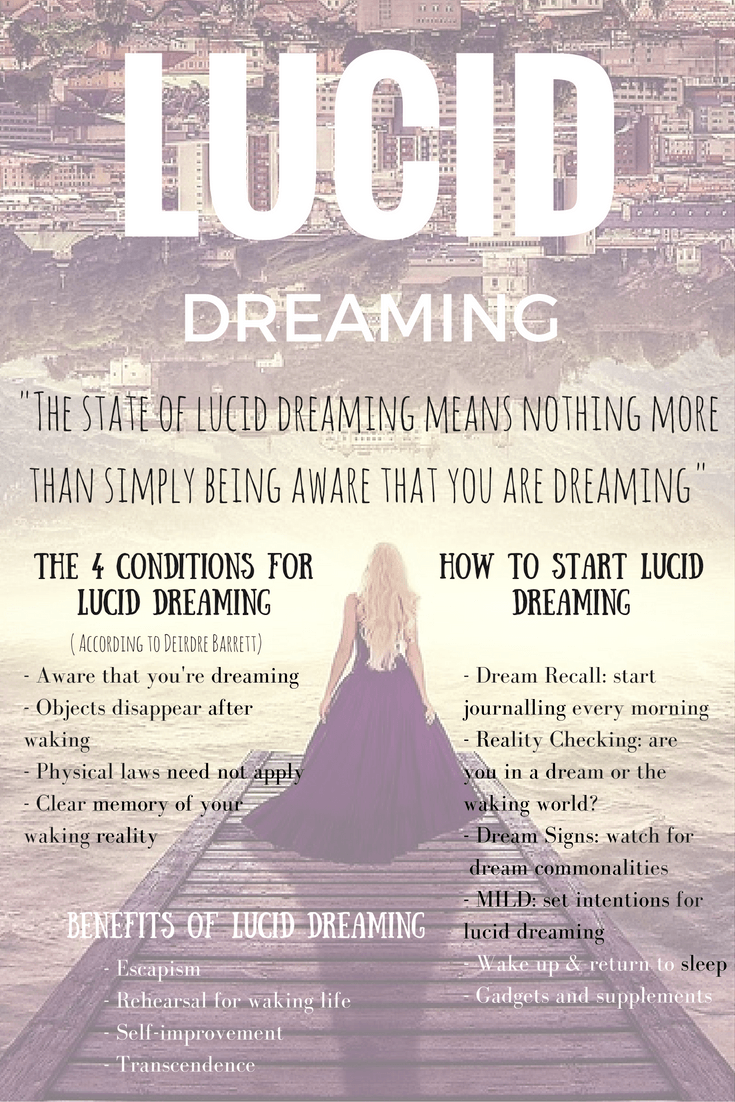Lucid dreaming is a trendy term bandied about nowadays by Silicon Valley execs looking for escapism, as well as some pretty hippy-dippy looking new age mystics.
But there’s so much more to it than that. Not only is lucid dreaming one of the most liberating ways to spend your sleeping hours, it can also have profound benefits on your waking life too.

A guide to lucid dreaming
Let’s find out more.
Contents
What is Lucid Dreaming?
‘Lucid dreaming’ as a term was first used by Dutch psychiatrist Frederik van Eeden in 1913. In an article entitled A Study of Dreams, van Eeden described his dream lucidity thus:
I had a full recollection of my day-life, and could act voluntarily, though I was so fast asleep that no bodily sensations penetrated into my perception.
But the actual concept of lucid dreaming has been around for much longer.
The state of lucid dreaming means nothing more than simply being aware that you are dreaming.
There is a spectrum of awareness in lucid dreaming: from just the tiniest inkling that you’re in a dream world rather than reality, all the way through to being able to control your actions, perceptions and figures around you in your dream world.
Whatever stage you’re at, it’s all lucid dreaming. And you can even train yourself to reach higher levels of lucidity, if you so desire. More on that later…
But while van Eeden coined the actual term that stuck in 1913, people have been practising lucid dreaming for almost all of recorded time.
Greek philosophers, like Aristotle, were partial to lucid dreaming while the practice has been a long established part of Tibetan Buddhism — known there as dream yoga — and in ancient Hinduism — known there as yoga nidra.
The Science of Lucid Dreaming

REM (rapid eye movement) sleep is a deep phase of sleep that usually occurs around 90 minutes in the sleep cycle. Normal dreaming usually occurs in REM sleep too.
What takes a normal dream to a lucid dream has been much hypothesized.
J Allan Hobson, a neuroscientist, has a popular theory that the first step to lucidity is to recognise that you’re dreaming. It’s thought that this recognition is sourced from the dorsolateral prefrontal cortex — an area of the brain where working memory occurs, and a part that is normally inactive during REM sleep.
With the activation of this area, your working memory comes into play and you are much better equipped to realise that you’re dreaming — usually because something happens that’s outside the scope of everyday reality.
The Conditions of Lucid Dreaming
So what actually makes a lucid dream, beyond just being generally aware that you’re dreaming?
Scientists and lay people have long been battling to define lucidity in the dream state, and two figures in particular have come up with certain conditions they consider have to be present for a dream to be lucid.
First off, Paul Tholey defined 7 conditions:
- Awareness of the dream state
- Awareness of the capacity to make decisions (and perhaps even control the environment and figures around you)
- Awareness of memory functions (remembering your waking reality)
- Awareness of self
- Awareness of the dream environment
- Awareness of the meaning of the dream
- Awareness of concentration and focus (as you try to remain asleep and not wake up)
These were later refined and reduced by Deirdre Barrett:
- The dreamer is aware that they are dreaming
- Objects disappear after waking
- Physical laws need not apply in the dream
- The dreamer has a clear memory of the waking world
The Benefits of Lucid Dreaming
At its most base level, lucid dreaming is a form of escapism.
In an age where our waking lives are heavily monitored and regulated, where we’re hemmed in by 9-5 jobs, societal pressures, mortgages and family, being able to escape to a dreamworld where you can create situations for yourself, act out your wildest fantasies and simply leave reality behind, should not be underestimated.
The higher level of lucidity you can achieve, the greater the escape you can create for yourself. At this level, you’ll realise that there is nothing to fear and everything to gain from creation and experimentation in the dream state.
Some people use lucid dreaming as a self-improvement tool to benefit their waking lives.
You could use the dreamscape as a rehearsal of something you need to do that you might be feeling anxious about. Having a conversation with a loved one, for instance, practising a foreign language or developing new skills.
Others use lucid dreaming as a time for overcoming nightmares and creative problem-solving, while others go further still in exploring their minds and the known universe.
There have been links made between lucid dreaming, religiosity and total transcendence — finding meaning beyond our waking reality.
The lucid dream world really is your oyster.
Who Can Do Lucid Dreaming?
While some people may be more naturally predisposed towards lucid dreaming, the truth is that anyone can do it.
Some of you may require weeks, months, years of training before being an adept lucid dreamer, while others may have been regularly indulging in the practise since childhood.
Regardless of any natural proclivity towards it, it’s true that everyone can benefit from training to hone their technique, increase the level of their lucidity and make the most of the dreamworld.
How to Start Lucid Dreaming
If you’re wondering how to start or how to increase and improve your lucid dreaming, you should consistently practise the following exercises:
- Dream Recall
If you ever wake up from a slumber and think to yourself that you’ve just experienced a dreamless sleep, you’re wrong.
We all dream, every night, without fail.
We just don’t always remember them.
In order to get better at remembering your dreams, you should actively try to recall them first thing when you wake up. The best method of doing this is to keep a notebook by your bed and jot down anything you can remember while it’s still fresh in your mind.
By training yourself in dream recall, you’ll be better able to spot the differences between dreams and reality and any patterns that emerge in your dreaming. This will better equip you to recognize that you’re dreaming, taking you to a state of lucidity.
- Reality Checking
In the same spirit as the above, practising reality checks will again allow you to spot if you’re dreaming or not.
A few times throughout the waking day, you should perform the following reality checks:
- Read some text, in a book or on a screen, look away and then glance back. If the text is now incomprehensible, you’re dreaming.
- Look at your hands and feet — do they look normal? If not, you’re dreaming.
- Close your mouth and briefly pinch your nose. Can you still breathe? If you can, you’re dreaming.
By regularly performing these reality checks in your waking life, you’ll condition yourself to perform these checks during your dream life too. These checks will help you recognize a dream and achieve lucidity.
- Watch out for Dream Signs
The first two exercises will prepare you to be more aware of dream signs — whether that’s recognizing patterns that you often experience or alerting yourself that you’re not in waking reality.
Other common dream signs that could help you recognize a dream include:
- Your teeth crumbling and falling out
- Finding yourself naked
- Seeing people that you know to be dead
- Being chased
- MILD
One surefire way to try and induce lucid dreaming is practising MILD: Mnemonic-Induction of Lucid Dreaming.
Before falling asleep, while in bed, you should set an intention to lucid dream that night.
In practise, that means repeating a mantra — like, “I know I’m dreaming” — a few times, out loud, before you go to sleep. You may need to experiment with how many times you repeat the mantra for best results. Ideally, you should repeat it enough times so that you remember it during the REM sleep phase.
- Wake Up and Return to Sleep
Another popular way to induce lucid dreaming is to actually wake up in the midst of a dream, within the REM sleep phase. You will need to study your sleep cycles and set an alarm in order to determine the best time to wake.
After waking, spend a few minutes setting an intention to lucid dream using MILD above, then fall back asleep after 10 minutes or so. You should find that you then drop back into REM sleep and lucid dreaming.
- External Stimuli
There are a few gadgets on the market that claim to be able to induce lucid dreaming.
Those include light emitting devices that gently nudge you into a state of dream recognition. Light emitters are generally more effective than sound emitters, which are likely to totally wake you up.
Some people have also experimented with supplementation to induce and extend lucid dreaming states.
- Sleep Well
One of the best ways to prepare for lucid dreaming and to be in a fit state to recognize dream signs is to actually sleep restfully.
Keep to a regular sleep schedule and perhaps even practice meditation to ensure a sense of calm and mindfulness.
Lucid Dreaming Resources
If you want to find out more about lucid dreaming, start here.
(For more sleep resources, take a look at our mammoth list of 79 of the best sleep tools and resources!)
Articles
The Ways to Control Dreaming: A good introduction to lucid dreaming in the Atlantic, together with the science and some relevant studies behind the phenomena
The Mysteries of ‘Lucid’ Dreaming: The Guardian explores what lucid dreaming can tell us about the brain
7 Steps to Start Lucid Dreaming: A Life Hacker article designed to get you started in the act of lucidity
Lucid Dreaming: A Beginner’s Guide: By Tim Ferriss
Websites
Lucidity: A site dedicated to the art of and experimentation within lucid dreaming
World of Lucid Dreaming: A site exploring the what, how and why of lucid dreaming
Lucid Dreaming Sub-Reddit: A discussion forum and support network on the whys and hows of lucid dreaming.
Scientific Studies
Sleep: Inducing lucid dreams: A 2014 study
Minding the dream self: perspectives from the analysis of self-experience in dreams: A 2013 study
Consciousness in dreams: A 2010 study
Gadgets & Supplements
Neuroon Lucid Dreaming System: A high-tech app dedicated to encouraging and developing lucid dreaming, consisting of 3 modules: guided meditations before falling asleep, external stimuli during REM sleep, a sleep diary and reality check training
Lucid Dreaming Induction: Binaural Beat Brainwave Subliminal Systems
MindPlace Proteus USB Light & Sound Meditation Mind Machine: Guided meditation and stimuli to induce lucid dreaming
Dream Leaf Advanced Lucid Dreaming Supplement: Contains 5-HTP, mugwort, huperzine-A, choline bitartrate and Alpha GPC
Higher Level Nutritionals Lucid Dreaming Supplement: Contains Choline Bitartrate, EGCG, Huperzine A, 5-HTP, Melatonin, B-6 and B-12
Anima Mundi Apothecary – Organic Loose Leaf Dream Tea: Contains calea, ashwagandha, kava kava, rama tulsi and mulungu
Books & Courses
Exploring the World of Lucid Dreaming: By Stephen LaBerge and Howard Rheingold
Lucid Dreaming, Plain & Simple: Tips & Techniques for Insight, Creativity & Personal Growth: By Robert Waggoner & Caroline McCready
A Course in Lucid Dreaming: A home study course by the Lucidity Institute that takes a minimum of 4 months to complete.









2 Comments
For similar stuff check out http://www.livinluciddreams.com
Can I put some of these reviews on our site? http://www.livinluciddreams.com